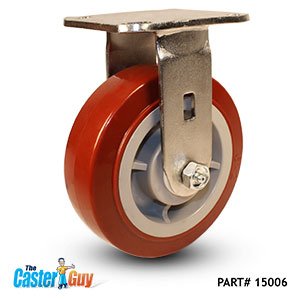
When shopping for casters, you’ll probably encounter stem casters. They are characterized by a rod-shaped stem at the top. While plate casters have a flat plate, stem casters have a stem. There are different types of stem casters, however, some of which include the following.
#1) Threaded
Threaded stem casters feature external threading. The stem is essentially a bolt. It’s covered in external threading that allows it to mate with internal threading. You can switch threaded stem casters into threaded holes on the bottom of furniture, carts or other objects.
#2) Expansion
Some stem casters are able to expand when placed inside of objects. Known as expansion stem casters, they feature a hex nut below the lower raceway. You can turn this hex nut to expand a rubber adapter around the stem. As the rubber adapter expands, the expansion stem caster will achieve a tighter and more secure fit.
#3) Square
While most stem casters feature a round, cylindrical stem, others have a square stem. Square stem casters aren’t as common as their round counterparts. Nonetheless, they offer an alternative rolling solution. If an object has round holes on the bottom of it, you can use round stem casters. If an object has square holes, conversely, you’ll need to use square stem casters.
#4) Grip Neck
There are also grip neck stem casters. Grip neck stem casters are commonly used on furniture. They feature a rod-shaped stem that’s slightly narrower at the top. Because the top of the stem is narrower than the bottom, they can grip the holes with which they are used. Grip neck stem casters are easy to mount and roll smoothly, making them a popular choice for many furniture applications.
#5) Grip Ring
Also known as friction casters, grip ring casters feature a ring at the base of the stem. The ring is typically made of brass or a similar metal. When installing a grip ring stem caster in a hole, the ring will create friction. This friction will hold the grip ring caster in place so that it doesn’t fall or otherwise become loose.
#6) Metric
In applications where precision is required, you may want to choose metric stem casters. Metric stem casters have external threading — just like regular threaded stem casters. The difference is that they use metric measurements. You’ll need to match metric stem casters with the size and thread count of the holes. Each metric stem caster must match that of the hole with which it’s used.

